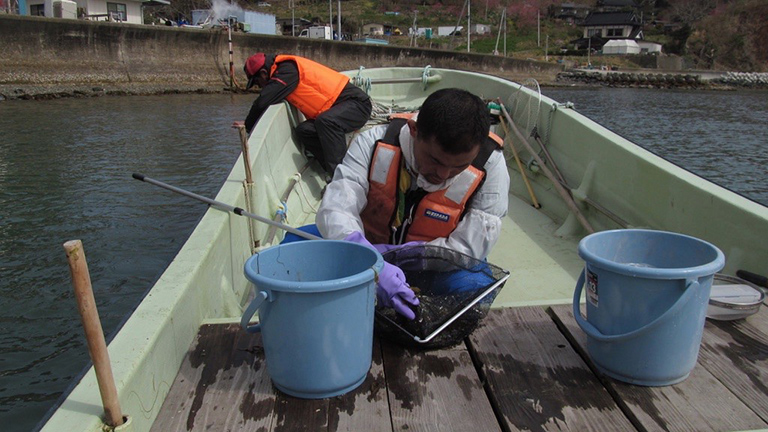The Mitsui & Co. Environment Fund
Introduction to Grant Projects
Satoumi Farm
Study of marine impact of wakame seaweed farming in the Sanriku region and regeneration and maintenance of rock fishing spots and seaweed beds
Activity grant
- Project Description
Wakame farming is an active industry in Shizugawa Bay, Minami Sanriku, Iwate Prefecture, and as a traditional fishing method, stem residue left over from the process of scraping away the mekabu (the flowering part of wakame) is disposed of in the sea as food for sea urchins. With the permission of the Japan Coast Guard, a survey will be carried out over three years to identify whether the more than 2,000 tons discarded per year is actually consumed by sea urchins, and whether the remaining stems actually completely decompose over time. The survey will also identify any connections between this practice and the bleaching of rock fishing spots and rapid growth of sea urchin populations in the region. The project will also conduct research and development of water quality improvement agents utilizing stem residue in order to promote the regeneration of seaweed beds and rock fishing spots. The field of activity has been specified as the seaweed beds and rock fishing spots of Shizugawa Bay, Minami Sanriku was registered by the Ramsar Convention in October 2018. [No. K18-0093]
Mitsui & Co. Environment Fund FY2018 Activity Grants List (PDF 372KB)
- Fields
- Resource Circulation
- Grant year
- FY2018 Activity Grants
- Grant term
- 3 years (April 2019 - March 2022)
- Grant amount
- ¥3,300,000
- Activity region
- Minamisanriku, Miyagi Prefecture

Overview of the Organization

- Project organization
- Satoumi Farm
- Representative
- Representative Director: Katsuya Kanefuji
- Establishment
- 2011
- Establishment Purpose
- Established with the aim of solving regional issues by working with local residents and promoting harmony with nature in Minamisanriku, which was affected by the 2011 Tohoku earthquake and tsunami.
- Recent Activities
- Aiming to solve problems in Minamisanriku resulting from the 2011 Tohoku earthquake and tsunami, we focus on care of the elderly and children, regeneration of the community and preservation of the natural environment.
- Staff
- Number of Full-time employees: 3 / Number of Part timers: 5 / Number of Members: 36
- WEB site
- http://satoumifarm.org
- Voice of Representative
- By visually showing the impact of aquaculture in Minamisanriku, where the practise is common, I want to contribute to enlightenment in the region.